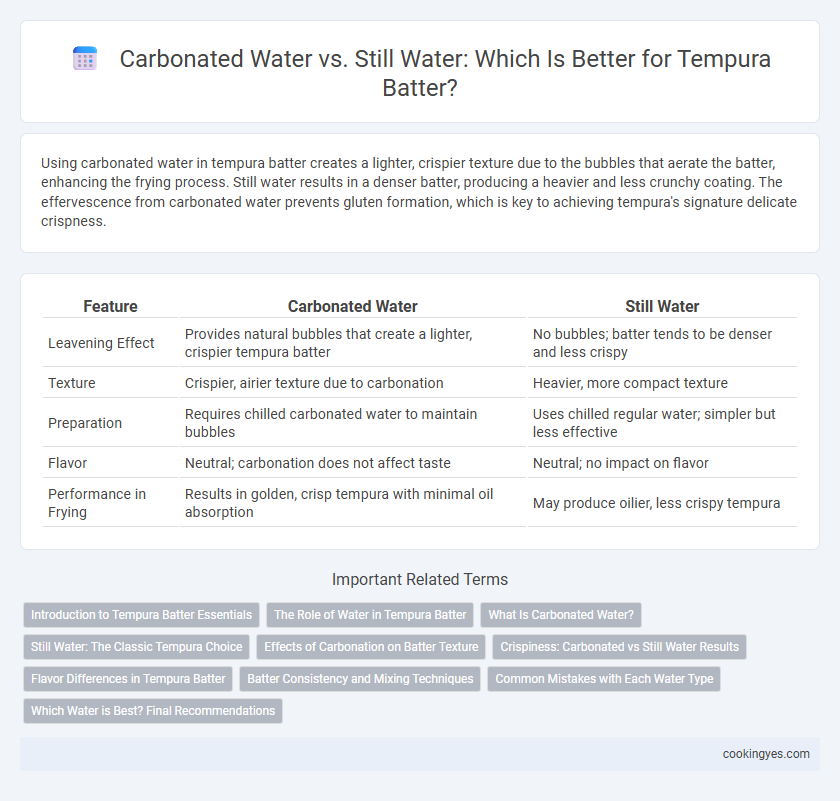Using carbonated water in tempura batter creates a lighter, crispier texture due to the bubbles that aerate the batter, enhancing the frying process. Still water results in a denser batter, producing a heavier and less crunchy coating. The effervescence from carbonated water prevents gluten formation, which is key to achieving tempura's signature delicate crispness.
Table of Comparison
| Feature | Carbonated Water | Still Water |
|---|---|---|
| Leavening Effect | Provides natural bubbles that create a lighter, crispier tempura batter | No bubbles; batter tends to be denser and less crispy |
| Texture | Crispier, airier texture due to carbonation | Heavier, more compact texture |
| Preparation | Requires chilled carbonated water to maintain bubbles | Uses chilled regular water; simpler but less effective |
| Flavor | Neutral; carbonation does not affect taste | Neutral; no impact on flavor |
| Performance in Frying | Results in golden, crisp tempura with minimal oil absorption | May produce oilier, less crispy tempura |
Introduction to Tempura Batter Essentials
Tempura batter essentials emphasize using carbonated water to enhance crispiness and lightness by introducing tiny bubbles that create a delicate texture. Still water results in a denser batter, lacking the airy crunch characteristic of ideal tempura. Japanese chefs prefer chilled carbonated water to achieve a perfect balance of crispness and tender interior in tempura dishes.
The Role of Water in Tempura Batter
Carbonated water introduces tiny bubbles that create a lighter, crispier texture in tempura batter by aiding in aeration and reducing gluten formation compared to still water. The carbon dioxide in sparkling water helps to leaven the batter, resulting in a delicate, airy coating that enhances the overall mouthfeel. Using still water produces a denser batter, which can lead to a heavier, less crispy tempura crust.
What Is Carbonated Water?
Carbonated water is water infused with carbon dioxide gas under pressure, creating bubbles that introduce lightness and aeration. In tempura batter, carbonated water helps produce a crispier and more delicate texture by reducing gluten formation during mixing. Using still water lacks this effervescence, often resulting in a denser and less airy tempura coating.
Still Water: The Classic Tempura Choice
Still water is the classic choice for tempura batter because its neutral temperature and lack of carbonation help create a smooth, consistent mixture that promotes even frying. The absence of bubbles in still water prevents excessive batter puffing, resulting in a delicate, crisp crust with a tender interior. This traditional method ensures optimal texture and enhances the natural flavors of the ingredients.
Effects of Carbonation on Batter Texture
Carbonated water introduces tiny bubbles that create a lighter, crispier tempura batter by increasing aeration and reducing gluten development. The effervescence in carbonated water helps achieve a delicate, crunchy texture that still water typically cannot provide. This carbonation effect enhances the batter's ability to puff up during frying, resulting in a more tender and airy tempura crust.
Crispiness: Carbonated vs Still Water Results
Using carbonated water in tempura batter enhances crispiness by creating lighter, airier bubbles that expand during frying, resulting in a delicate, crunchy texture. Still water produces a denser batter with fewer air pockets, leading to a thicker and less crisp coating. Studies and chef experiments consistently show carbonated water as the superior choice for achieving the iconic tempura crunch.
Flavor Differences in Tempura Batter
Carbonated water creates a lighter, crispier texture in tempura batter due to the bubbles that aerate the mix, enhancing the overall flavor experience by allowing the ingredients to shine through without heaviness. Still water results in a denser, more uniform batter, which can produce a richer taste but risks masking the delicate flavors of seafood and vegetables. Flavor perception in tempura is significantly influenced by the choice of water, with carbonated water providing a cleaner, more vibrant bite.
Batter Consistency and Mixing Techniques
Carbonated water creates a lighter, crispier tempura batter by introducing tiny gas bubbles that enhance batter consistency and texture. The effervescence allows for minimal mixing, preventing gluten development and ensuring a delicate, airy coating. Still water requires more careful mixing to avoid a dense batter, resulting in a heavier crust and less crispiness.
Common Mistakes with Each Water Type
Using carbonated water in tempura batter is often praised for creating a light, crispy texture, but a common mistake is over-mixing, which can cause the bubbles to dissipate and the batter to become dense. Still water, while more stable, frequently leads to a heavier and oilier tempura when the batter is mixed too vigorously, resulting in a loss of desired lightness. Both water types require minimal mixing to maintain the right balance of aeration and batter consistency for optimal tempura.
Which Water is Best? Final Recommendations
Carbonated water creates a lighter, crispier tempura batter due to its bubbles that introduce airiness, enhancing texture and preventing gluten development. Still water produces a denser batter that can absorb oil, resulting in a heavier, greasier tempura. For the best tempura, using cold carbonated water is recommended to achieve a delicate, crunchy coating that complements fresh Ingredients.
Carbonated water vs still water for tempura batter Infographic

 cookingyes.com
cookingyes.com